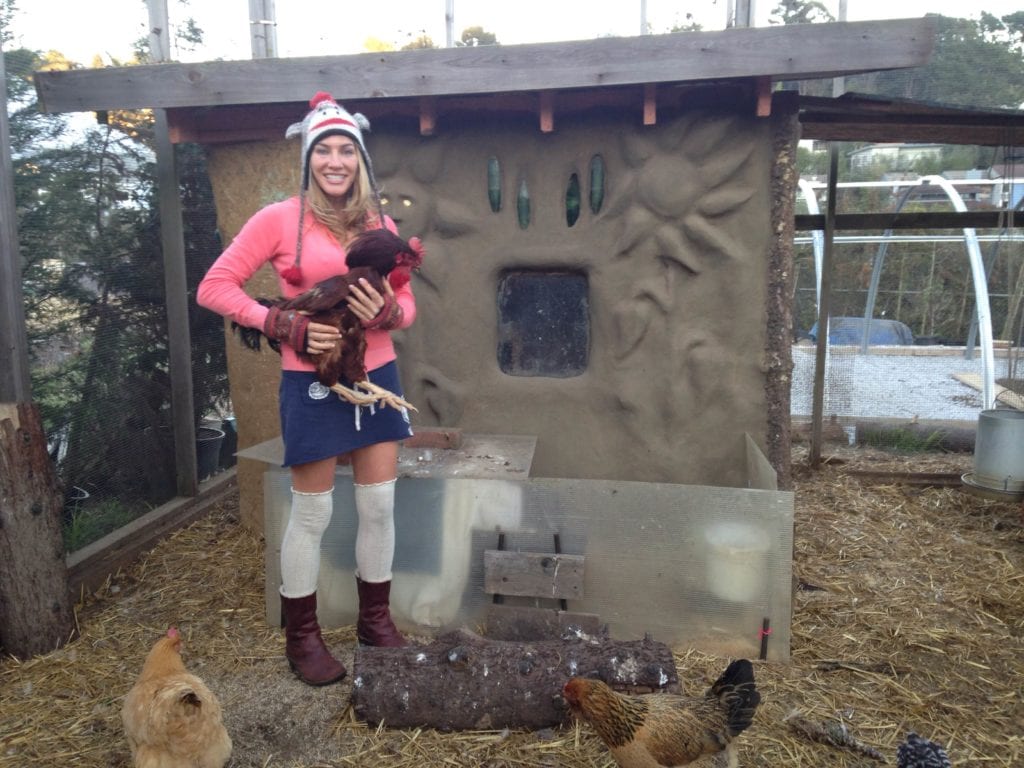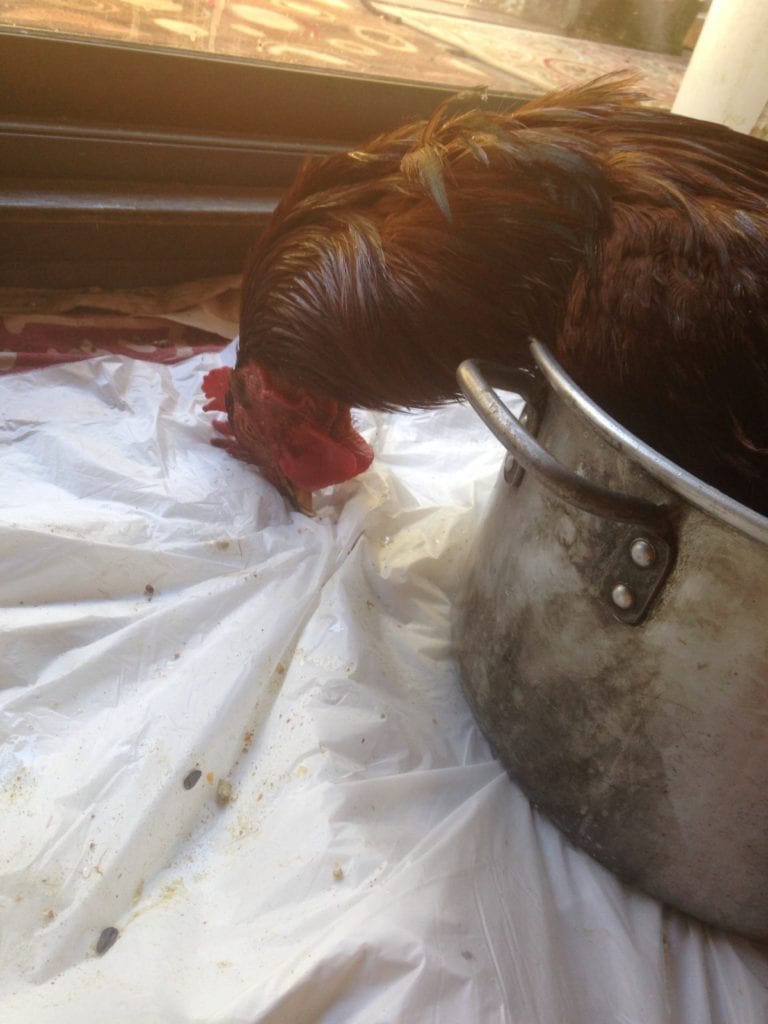
Story and photos by Murray Schneider
Jesse James had a really sore toe!
Tori Jacobs, an Ecology Center of San Francisco co-founder and volunteer, sat at Higher Grounds on a recent December afternoon. She nursed a Chenery Street latte and explained.
“Jesse picked up a stone in August and it lodged in the crevice of his right foot and skin began growing over it,” Jacobs said. “I removed it, but Jesse began limping, so on the advice of veterinarians I began soaking his foot in hot water at the farm.”
She’d just returned from the School of the Arts farm where she’d also nursed Jesse, a four-year old farm rooster that she’d raised from a chick when she lived on a ranch owned by Half Moon Bay’s Feed and Fuel and that, until he’d hit his rocky road, had lived the good life.
The school farm is situated on the former J. Eugene McAteer High School football field, and each Thursday afternoon from 3-5 P.M. it sells, when in season, cabbage, rainbow chard, tomatoes, Quinoa, bush beans and corn.
And thanks to Jesse James and his brood of hens, plenty of eggs, as well.
Jacobs soon determined how serious Jesse’s injury might become, so she put out feelers to her network Facebook Farmer Friends.
She spoke with Hank Will in Nebraska, the editor of Grit Magazine, which has been writing about rural American know-how since 1888, and Victoria “Redhead” Miller who wrote “Pure Poultry – Caring for Chickens.”
“I even chatted with Alfon Baneres of Surgeons for Wild Animals and Birds of Prey, a clinic in Pamplona, Spain,” said Jacobs.

Eventually Jacobs visited Noah Stroe, a veterinarian in the Excelsior District, who took X-rays. Jesse appeared on the mend, seemingly dodging a catastrophic bone infection.
“At the end of August he seemed okay,” said Jacobs, who was born in Minnetonka, Minnesota and spent childhood summers on relatives’ farms, and so she’s no stranger to barnyard denizens.
“He even resumed his daily ‘Happy Dance’ with his 24 hens,” Jacobs said.
Actually, Jesse got down to some serious business again, safeguarding his harem from marauding Glen Canyon raccoons, refereeing daily hen house pecking order drama and resuming his courtship chores, albeit without the same alacrity.
Jesse’s health didn’t get better, though.
“Only a week or two later Jesse could hardly make it to the feeder at the farm,” Jacobs said. “He was stationary, simply perching.”
Matters became so critical she bundled Jesse up and accompanied him to her Valletta Court house, which sits across O’Shaughnessy Boulevard from Glen Canyon and directly across the street from Jeanne Halpern’s California native plant garden.
“My three Facebook friends advised me to up the Epsom salts soaking regimen to three times a day for 20 minutes. I kept Jesse close by, next to my bed.”

“Suspecting a bone infection, Dr. Stroe put Jesse on anti-biotics and pain meds,” she continued. “I put them in some grapes, which he loved.”
Dr. Stroe suggested a consultation, so Jacobs drove to the Sunset District and landed at Bay Area Bird Hospital on Taraval Street in the Parkside.
The diagnosis was bad; Jesse indeed suffered from a bone infection in his right small toe.
“Without surgery, the infection would spread from the bone in his toe to the main bone in his leg – at that point the leg would need to be amputated,” said Jacobs. “Jesse wouldn’t have quality of life with one leg. He couldn’t stand, and at that point he’d have to be euthanized.”
Jesse toe needed to be removed, so Jacobs scheduled surgery for December 17.
The procedure costs $1,500. ECO-SF had footed all the bills for Jesse’s ailing toe. Jacobs had even reached into her own, not so deep, pockets to pay Jesse’s ballooning veterinary costs.
Within 10 minutes of the operation’s start, Jesse’s heart stopped and he was gone.
“I had a premonition, like Jesse was signaling me. I was driving when I got the call from the doctor,” said Jacobs. “I learned the infection had spread to his leg after all, and there would only have been a slim chance he could have kept it.”
Tori Jacobs is Hollywood statuesque, given over to wearing urban chic ensembles that belie her rustic roots. She drives a vintage 1988 Honda hatchback that boasts 200,000 miles, which may even be some sort of record for frugal Minnesotans. There is nothing pretentious about Jacobs, nothing put on about her except her sophisticated, put together outfits that she secures in thrift stores.
Before arriving in San Francisco, she lived in Half Moon Bay where she raised chickens. She graduated Hunter College with a Bachelor of Fine Arts in 2000, parlaying the degree with a 2008 MA from New College in San Francisco in Activism and Social Change. Synergistically, it all fits in well with ECO-SF, an outdoor experimental living learning space located at Ruth Asawa School of the Arts and the Academy of Arts and Sciences, that trumpets, among many events, baking in an earth oven and workshops that deal with medicines of California.
Jacobs is bright, energetic and nothing if not resourceful, and left no stone unturned to put-to-rights the alien pebble that plagued Jesse.
“The Bay Area Bird Hospital donated $500 to Jesse, and Dr. Leila Marcucci and Dr. Lynn Dustin obtained matching funds from San Francisco Aid for Animals,” said Jacobs.
The Bay Area Bird Hospital has provided veterinary care exclusively for birds, reptiles, rabbits, rodents and small exotic animals since 1989, and the SFAFA was created in 2009 by the San Francisco Veterinary Association to provide aid for pet owners unable to afford lifesaving care.
“The SFAFA fund has established a set of criteria that allows participating veterinarians to determine whether a client is eligible to benefit from the fund,” Jacobs explained. “Criteria include need and a reasonable expectation that the pet’s condition is curable with enough supportive care.”
She began scrolling through pictures of Jesse found on her smartphone. She stopped at one, which depicted Jesse soaking in a metal pot at her house. Desolate, Jesse’s head had languished over the pot’s edge.
“The SOTA student Ecology Club planned several fund raisers to help defray the medical costs,” said Jacobs. “The first one will be a pizza party when we fire up our earth oven.”
All of which speaks to the sense of community emblematic of what ECO-SF has created over the last four years atop windswept Diamond Heights.
“Here at the farm we’re encouraging people to live a caring, local life style,” said Jacobs. “We want people to grow their own food for their own security and to end unacceptable animal cruelty.”
“Jesse is no longer with me, but his story still needs to be told,” she continued. “Jesse speaks for all animals; they are our equals and we’re not their bosses and it’s so important to treat them correctly.”
“Jesse was a member of the Ruth Asawa family and we valued him.”
“We couldn’t afford the full amount of the surgery, so the hospital, the grant, and SOTA and Academy support made a difference between a ‘Yes, we will go forward with the surgery,’ or ‘since we can’t afford it, we will have to put Jesse down because we don’t want him to suffer.’”
“Jesse needed our compassion; he needed our support.”
Tori Jacobs stood and walked into the village mid-day sunshine. A 36-Teresita halted to a stop, preparatory to making its left turn onto Diamond Street.
“You know, roosters can live to be 20 years old, but generally they live to be eight to 12, the same as a dog,” she said. “Jesse didn’t get that opportunity, but while he was with me he loved to be held and nestle in my shoulder. He was pure love.”
“It’s so rare for a rooster to be so affectionate,’ she went on. “Among all the other reasons, that’s why we tried to save him.”
********
For those who would like to learn more about the ECO-SF student farm on the Ruth Asawa campus, they can go to www.glenparkassociation.org. Link to Glen Park News Back Issues and scroll to the Fall 2013 edition.
For those of you who would like to find out more about the Ecology Center of San Francisco go to www.eco-sf.org.